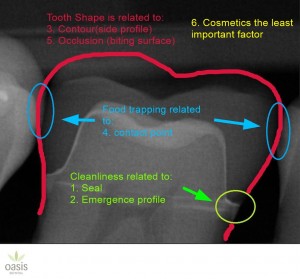Six steps to quality dental restoration
Thursday, December 12, 2015

My practice is all about restorative dentistry – getting my patients’ teeth as close as possible to their natural state.
When I see patients, I advise them that it’s crucial for them to know how to assess good dental work and to not place blind faith in their dentist, even me! I like to talk them through how they’ll be able to see for themselves whether I’ve done a good job; or any other dentist for that matter.
The key to a dental restoration – which includes fillings, crowns and veneers – is for the dentist to restore the tooth as close to its natural form as possible.
This is crucial to preventing further problems as it will ensure that at home cleaning is as easy as possible. Although the cosmetics of the restoration are important, this is actually the least important aspect of having a functioning set of teeth.
There are six elements of a good dental restoration, listed here in order of importance:
Seal
The seal is similar to waterproofing. It must stop leaks and access for bacteria getting in and causing more damage to your tooth. The seal of any dental restoration is the most important factor and must never be compromised.
Emergence profile
How well you can clean around a restoration is dependent on the emergence profile creating an overall smooth surface – like good woodwork joinery that you can’t feel when you run your hand over it. Floss must not catch or shred in any way on your restored tooth.
Contour
Teeth are generally round and curved, and restorations should follow the natural shape of the tooth. Square corners break, shred floss and cause ‘overhangs’ where bacteria will hide and breed.
Contact point
Every tooth has a neighbour – two in fact. The relationship with these neighbours must be consistent with the rest of your mouth. Teeth should sit tightly up against each other, stopping food from getting jammed between them. We call this a ‘tight contact point’.
Occlusion (bite)
Your tooth also has another neighbour, like you do at home, on the other side of the road. This is the tooth on the other jaw that comes together to make the bite. Everyone feels a high bite but not if the tooth is not touching. The bite must not be too low, or the opposing tooth often over-erupts and this will result in an uneven bite in the future.
Cosmetics
In addition to the above 5 factors, your dental restoration should look good, although shouldn’t compromise the function. A poor cosmetic appearance is the only factor that won’t affect the health and function of a dental restoration.
The X-ray below shows how a quality dental restoration should look:
Next time you visit your dentist, make sure you know what you are looking for. Make sure that your dentist pays attention to all six aspects of your treatment so you can achieve the best outcome for your long-term health.
Want to know more? Read my blog on questions to ask your dentist
Posted in: Advice


This post is informative! The focus on getting the restoration as close to natural teeth as possible makes a lot of sense. It seems like it would not only improve functionality but also appearance. Are there any cosmetic dentistry services you offer that can help achieve a natural look for dental restorations, like crowns or veneers?
Thank you for outlining the six steps to quality dental restoration! Your detailed breakdown provides valuable insight into the restoration process and emphasizes the importance of each phase. This post is a great resource for anyone looking to understand how dental restorations are done. Fantastic job!
Thank you for outlining the six steps to quality dental restoration! Your detailed explanations provide a clear understanding of the restoration process and its importance. This information is invaluable for patients considering dental work. Great job making such a complex topic accessible!
Thank you for this detailed guide on achieving quality dental restorations! Your explanation of each step, from initial assessment to final placement, is incredibly thorough and informative. I appreciated the emphasis on the importance of precision and patient care throughout the restoration process. Your insights will undoubtedly help readers understand what to expect and how to ensure they receive top-notch care. Keep up the excellent work in providing such valuable and practical dental information!
This post provides an excellent overview of the steps to achieve quality dental restoration. The detailed breakdown of each step and its importance is incredibly useful for anyone considering restorative dental work. I especially appreciated the focus on thorough planning and attention to detail. Thanks for sharing these valuable insights to ensure the best outcomes for dental restorations!
Excellent guide on the six steps to achieving quality dental restoration! The thorough breakdown of each step, from diagnosis to final restoration, provides a clear understanding of the process and its importance. I especially appreciated the emphasis on precision and patient care throughout each stage. This is a fantastic resource for anyone looking to ensure they receive top-notch dental restoration. Thanks for sharing these valuable insights!
Thank you for outlining the essential steps for achieving quality dental restoration! The detailed explanation of each step provides valuable insights into what goes into successful restoration work. I particularly appreciate the emphasis on both the technical precision and the importance of patient communication throughout the process.
I’d love to know more about how these steps can vary depending on the type of restoration being done. Are there specific considerations or challenges for different types of restorations, such as crowns versus fillings? Thanks for sharing this comprehensive guide!